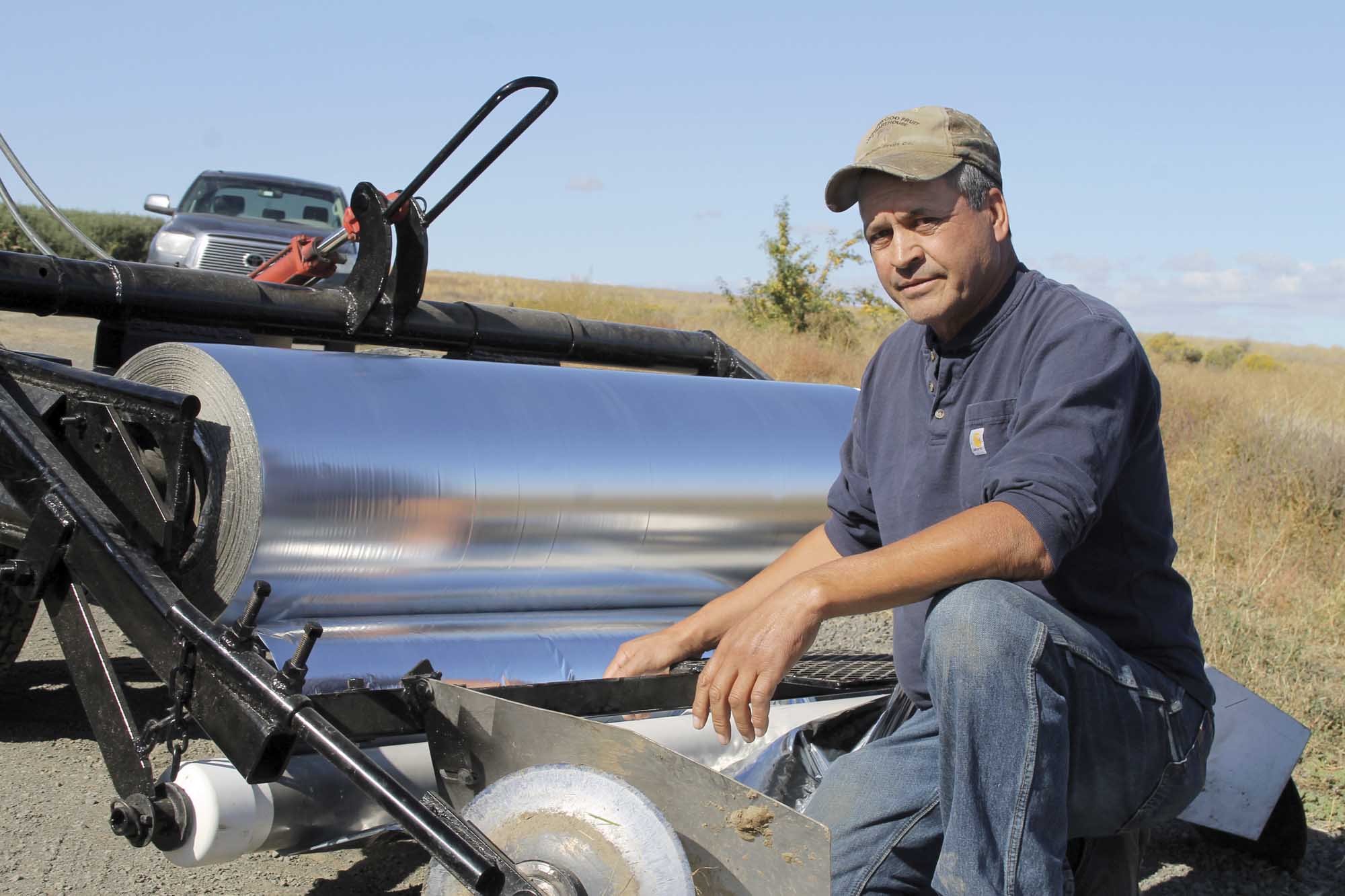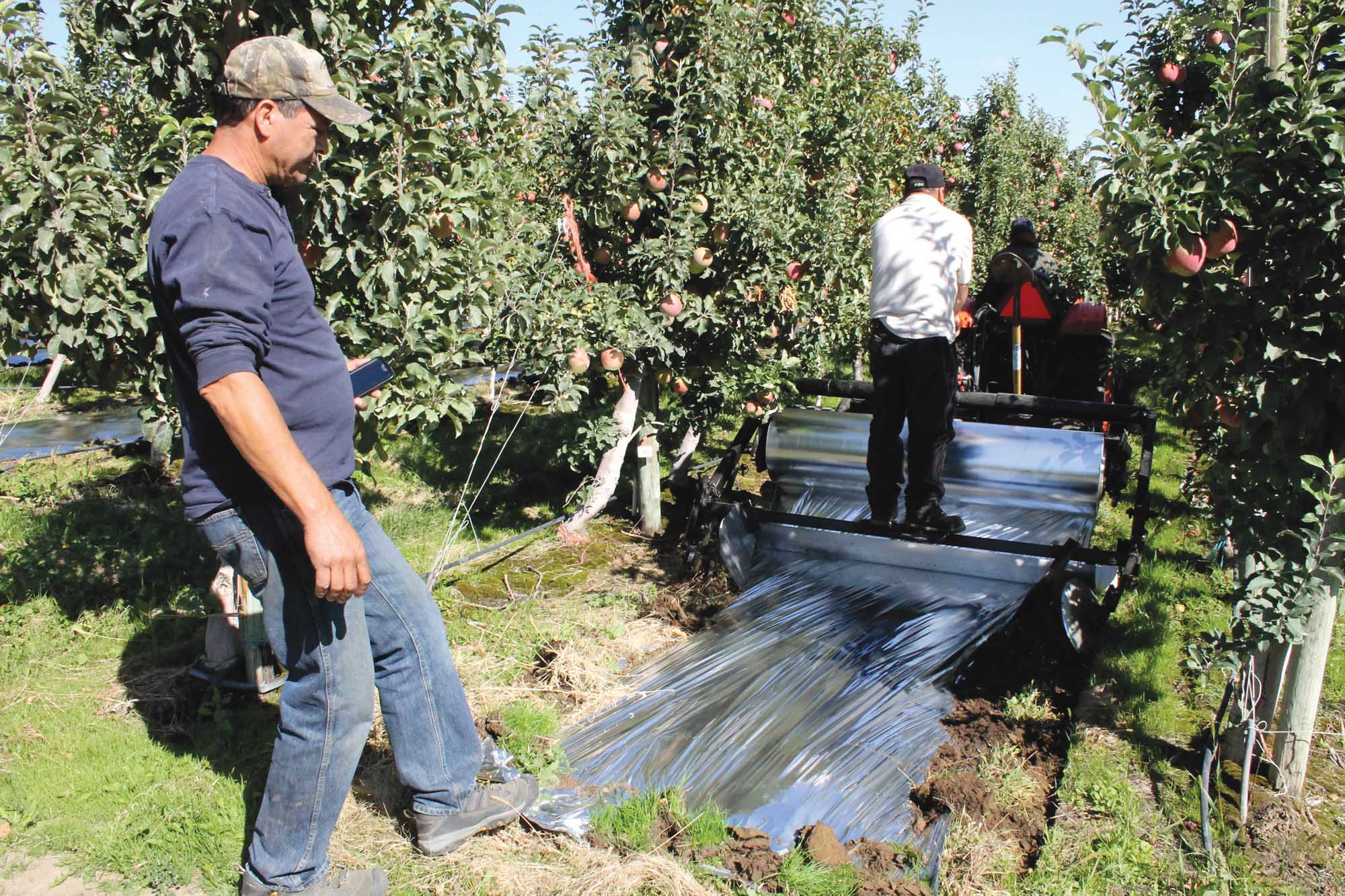
Antonio Montoya invented a machine that takes most of the labor out of laying a reflective mulch.
(Geraldine Warner/Good Fruit Grower)
As harvest approaches at Mount Adams Orchard, so does the once daunting task of laying a reflective mulch down each row of 160 acres of Gala apples and 80 acres of Fujis.
The Mylar-type reflective film colors up the apples by reflecting light from the ground back up to the trees. It is applied three weeks before harvest, within a tight time frame, so the fruit gains optimum color while it still has the internal condition needed for long-term storage.
Antonio Montoya, manager of the 600-acre orchard at Alderdale on the Horse Heaven Hills in south central Washington, said laying the film used to be a labor-intensive and time-consuming chore. One person drove the tractor pulling a roll of film, while two more workers with shovels walked behind, digging up sods of earth to place all along the edges of the film to secure it to the ground.
Three years ago, Montoya decided there had to be a more efficient and cost-effective way. After pondering and researching the problem for a few days, he hit on a solution.
Like most growers, Mount Adams had been buying the material in 4,000-foot rolls—enough for only a few orchard rows. Montoya learned that the material is made in China and imported into this country in master rolls of almost 40,000 feet. A California company cuts the master rolls into the smaller rolls for resale to growers. He found that he could buy master rolls for less than half the cost of the equivalent number of small rolls. He buys film in two widths: 60 inches wide for the orchard’s 4-by-10-foot plantings and 80 inches for the 5-by-14-foot blocks.
Next, he set to work to design a machine that would reduce the labor costs for laying the film. The machine he built, with the help of a couple of workers with welding skills, has a roller to hold the master roll and a disk at each side at the back that automatically digs up the soil and places it on the edge of the roll as it moves down the row. This eliminates the need for people to shovel the dirt.
Now, it only takes a tractor driver and one other person who stands on the back of the machine and whose only job is to secure the material with soil at the beginning and ends of the rows. The machine can be towed at a regular tractor speed of around 2-1/2 miles per hour, which means it can cover a row in just a couple of minutes. One roll is about enough to cover a ten-acre block, reducing the down time for changing rolls.
Tweaked
Montoya said he tweaked several aspects of the machine’s design. He added deflectors to keep the dirt on the edge of the material, and he added hydraulics to raise and lower the disks.
“The most challenging part was how to carry a roll that weighed 900 pounds without tearing the paper,” he said. “And it needs to roll very easily, but at the same time not so easily that when you stop it keeps unrolling.”
They now have two machines for laying 60-inch wide material and two for the 80-inch wide, which Montoya said is all they need because they can cover the ground so fast. The next step, he says, is to figure out how to have the machine automatically cut the film and set it in the ground so that it would take only one person instead of two.
Platform

The machine can accommodate a 40,000-foot roll of reflective material—about twice as much as shown in this picture and 10 times as much as in a standard roll. The job of the worker riding on the back of the machine is to cut the reflective material at the ends of the rows.(Geraldine Warner/Good Fruit Grower)
This is not the first machine that Montoya has designed and built. The company had purchased a commercially built orchard platform for work such as pruning and thinning, but it only accommodates four workers. Montoya built a self-propelled platform himself using the chassis from an old Nissan pick-up truck. He added a Honda engine and a hydrostatic transmission and made it big enough to hold eight workers so that four can prune while the other four train the trees in one pass through the orchard.
Since regulations stipulate that workers need to be harnessed if the platform is more than three feet high—as the commercial platform is—he made his 2 feet 10 inches high and placed a railing around the edge. It works well, but he’s still mulling over how to design a platform that will enable employees to work significantly faster than they can from ladders. He feels it needs to be designed specifically to match the planting system.
“I know how to improve this,” he said. “We’re going to be working on it. Not every platform will work with every different system.”
Mount Adams doesn’t use platforms for harvest. Montoya said he’s concerned about bruising of the fruit.
“It’s going to take time to design the right platform,” he said. “There’s a lot of good ideas. Eventually, it’s going to have to happen because the labor supply is getting tighter and tighter.”
Montoya has been with Mount Adams Orchard for 18 years. He managed establishment of the Alderdale orchard, from laying out the blocks and irrigation system to planting the trees.
Demonstration
Chihuahua
Montoya has always worked with apples. He grew up on his family’s apple orchard in Chihuahua, Mexico, which his father still owns. He earned a bachelor’s degree in horticulture at the university in Chihuahua and spent a year in Italy on a scholarship studying viticulture and horticulture.
In the late 1980s, he worked for a couple of years as in the orchard and packing house at Auvil Fruit Company, then returned to Mexico where he ran his own irrigation business, and installed microirrigation systems for orchards.
In 1996, he sold his business and moved back to the United States with his wife, Veronica. Mount Adams Orchard’s president Don Gibson was looking for a bilingual person with a bachelor’s degree to manage the new orchard, and Montoya qualified (though he was actually bilingual in Spanish and Italian, and only spoke a little English).
The Montoyas have a home at the orchard, which is in a remote location 30 miles from Prosser, the nearest city. Montoya says that gives him plenty of opportunities to read in his spare time—as well as think up new inventions. But he also likes learning about the past.
“If I was not an apple grower, I would be an archeologist,” he said. “I like history and reading about the Mayans, Egyptians, and Aztecs. And I like science. I love horticulture.” •






How do we come in contact with Antonia Montoya?